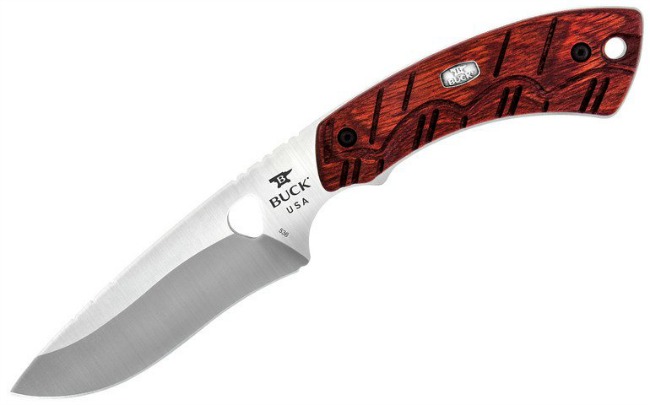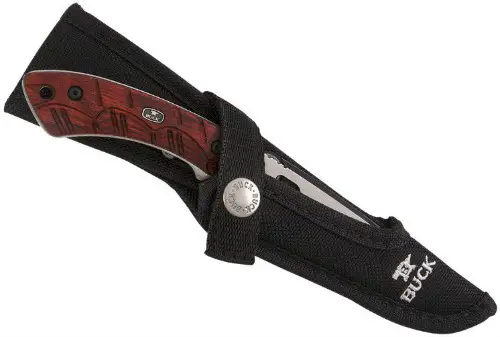|
Buck Model 536 Skinner Knife By Gary Zinn  Illustration courtesy of Buck Knives. The fixed blade hunting knives long made by Buck Knives are quite familiar to older hunters and outdoor enthusiasts. The Buck Pathfinder, Woodsman, etc., are distinctive and well regarded for their design, function and durability. These Buck Classic Fixed Blade Hunting Knives are among the few traditional outdoor knife designs that have endured to the present day. They and the Buck Model 110 lock back folder epitomize the term "Buck knife." In the last few years, Buck has launched a new Open Season line of knives. Currently, there are two sets of Open Season knives, labeled the Pro Series and the Avid Series. The Pro Series knives feature S35VN blade steel and micarta handles, while the Avid Series knives are made with 420HC steel and have handles of thermoplastic material. There are over a half dozen models or variants in each series, but detailing these is beyond the scope of this article. See the Buck website (http://buckknives.com) to explore the entire line. This is a review of the Model 536 Skinner knife. I thank the good folks at Buck Knives for providing the review knife. Specifications
I consider the Model 536 (Avid) and 537 (Pro) knives to be the keystone knives in the Open Season series, because they have a blade size and pattern that is suitable for most big game hunting situations. Many hunters would not need to carry another knife into the field. A drop point blade profile is a very good (and popular) choice in outdoor knives, because drop point knives generally have the versatility to field dress, skin and work up game animals, plus doing any number of other cutting chores. The drop point blade geometry of the Model 536/537 has this kind of versatility. I should mention that Buck calls this knife a skinner, but be aware that the blade pattern is not that of a true skinner (such as the Buck Model 103). However, the Model 536/537 blade has sufficient curve between the belly and tip to be effective for skinning, as well as other types of cutting. Another virtue of the fixed blade Open Season knives is their rugged simplicity. All feature full tang blades with handle scales attached to the tang with cross bolts and cap screws. There are no other items of "furniture" added on. The only thing simpler is a skeleton handle or self handle. A full tang, hafted with virtually indestructible handle scales, equals a tough knife. Any knife can be damaged by abuse or severe mishap, but a full tang fixed blade knife with sturdy handle material makes for a high degree of strength and durability. Here are some additional details about the Model 536. The satin finished blade sports the characteristic Buck high hollow grind, with the final sharpened edge formed by a narrow micro bevel. The factory edge easily made my top qualitative rating of sharpness, Extremely Sharp. (For more on rating knife sharpness, see Knife Sharpness, Sharpening Methods and Tools.) The steel is specially heat treated 420HC stainless, a long time mainstay in the Buck product line. Steel freaks may judge 420HC unfavorably in this age of super steels, but it remains a blade steel of proven performance and sharpens easily. Anyone who wants a premium steel in a Buck Open Season knife can opt for one with S35VN steel (e.g., the Model 537), at about twice the price of the equivalent knife with 420HC. The blade is 3.8mm (.15") thick at the spine; it tapers from 1-1/4" wide just forward of the finger choil to 1" wide at the midpoint, then tapers more rapidly to the tip. There is a small area of jimping on the spine, just forward of the choil. This is nice if one wants to use the knife with a thumb-on-top force grip. It bears noting that the cutting edge has a slight recurve between the heel and belly of the blade. This can complicate sharpening, especially on bench stones. The easiest way to avoid difficulties in sharpening the recurved portion of the blade is to do touch-up sharpening, early and often, using a ceramic rod (crock stick) sharpener. This knife got a good test of edge retention and sharpening while I was working on this review. My wife bought a new set of chairs for our patio. After unpacking them, I had a large, triple-ply, corrugated cardboard box to break down for recycling. I used the Model 536 knife for this and by the time I was done I could tell that the edge was fading. (Corrugated cardboard is a good test of edge retention.) I gave each edge of the knife a dozen strokes on the medium grit rods of my Lansky Masters Edge sharpening tool, followed by six strokes on the fine grit rods. This brought the edge back to Extremely Sharp condition, in less than five minutes. There have been some confused quotations of both blade and handle length of the Open Season knives. Facts: the useable working length of the Model 536 handle is 4-1/2", measured from the butt to the lip of the finger choil. The sharpened edge of the blade is 3-5/8" long, while the overall length of the knife is 8-7/16". The handle scales are 3-15/16" long, so do not fully cover the finger choil area. This, I think, is the cause of the conflicting length measurements. The Open Season handle is a great design. The saddlehorn handle profile looks modern and stylish. More importantly, it is ergonomic, so Open Season knives feel secure, handle deftly and can be worked hard without hand fatigue. My introduction to the Open Season handle design was on the Buck Model 550 Selector 2.0 Folding Knife. I was impressed with the feel of the handle right away and handling the Selector and Open Season knives has reinforced that impression. These knives have better ergonomics than most of the current generation of new knife designs. The handles are sized in proportion to the length and bulk of blades, so there are no universal measurements of handle dimensions for the Open Season knives. The Caper and Small Game are the smallest knives, so their handles are somewhat more svelte than those of larger models. To illustrate, the 4-1/16" long Model 538 Small Game handle is 5/8" thick at the middle, with width ranging from 9/16" at the throat of the index finger groove to 1" at the flared butt. By comparison, the Model 536 handle is 4-1/2" long, 11/16" thick at the middle, with width ranging from 13/16" to 1-1/4". Someone with very large hands would likely find the Model 536 more comfortable to use than the Model 538. In general, the Open Season handles should fit almost all users well. The Model 536 knife has neutral balance, in that I can hold it horizontally and it will not tilt forward if I open my hand. However, it feels slightly weight forward when I wield it. This is not surprising, considering the length and bulk of the blade. This knife will not feel quite as nimble as a knife that has a rearward, handle-heavy balance. Buck says that the handle scales of this knife are "red wood." This is disingenuous; the scales are red in color and superficially look like wood, but the material is thermoplastic. (I did a biopsy!) In fact, actual redwood (Sequoia sempervirens) would be a terrible knife handle material, because it is quite soft. Compared with rosewood (Dalbergia spp.), redwood is only half as dense and one-sixth as hard. Unlike redwood, rosewood is a good natural handle material. (I studied forestry in college, so I know how to evaluate wood properties.) That said, I am totally okay with the handle on this knife. Thermoplastic is a suitable handle material for a moderate priced working knife. I actually like the look of the faux wood scales. I also like the redesigned sheaths for the fixed blade Open Season knives. Sheaths for the Avid Series knives are polyester ballistic cloth, while leather is used for the upscale Pro Series knives. There is nothing startling about the materials, but there is something different about these sheaths. They are open backed, except toward the tip, and have a rigid plastic inner frame and liner. When the knife is inserted into the sheath, the finger choil fits into a rounded shelf on the liner; then the knife is secured in place with a snap strap. The system is quite secure, and it is easy to both sheathe and unsheathe the knife. These sheaths are high quality, well constructed and have a generous belt loop. They add value to the product package. Here is an image that shows the ballistic cloth sheath, although the plastic frame/liner is not apparent.  Illustration courtesy of Buck Knives. Conclusion Other Buck Open Season knives I have reviewed include the fixed blade Model 538 Small Game, Model 557 Folding Skinner and Model 550 Selector 2.0 folder. The latter shares the handle design of the Open Season folder. What I have learned leads me to believe that the Open Season knife line bids fair to become a new classic family of knives for Buck. They should help the Company maintain a prominent position in hunting/outdoor knives for a long time to come. |